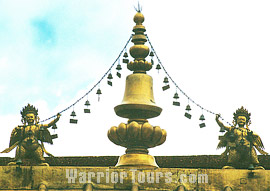Ganden Monastery

Ganden Monastery is about 47 kilometers (29 miles) from Lhasa and is situated on the Wangbur Mountain at an altitude of 3,800 meters (12,467 ft). As one of the 'Three Great Monasteries' of the Gelugpa Sect, Ganden Monastery is one of the largest and earliest monasteries in Tibet. Originally constructed in 1409 by the founder of the Gelugpa Sect, Tsong Khapa, is held in high esteem among the Gelugpa Sect. Tsong Kapa became the head of the Ganden Monastery (known as Ganden Tripa in Tibetan) until his death in 1419. In its heyday, Ganden Monastery covered an area of some 150,000 square meters (about 37 acres) and mainly comprised of the Coqen Hall, Tri Thok Khang, Serdhung, Zhacangs, Khangtsens and Myicuns.
The Coqen Hall is the main building of Ganden Monastery and it is situated in the north of the complex. As the main assembly hall, the Coqen Hall can hold more than 3, 000 lamas at any one time. Vivid statues of Tsong Khapa and Maitreya are worshiped here, while other delicate murals and sculptures can also be seen throughout the hall. Tri Thok Khang was the residence of Tsong Khapa and successive Ganden Tripas. It is said that Tsong Khapa died in a bed within Tri Thok Khang. Serdhung, or Tsong Khapa's Golden Tomb is devoted to the Stupa-tomb of Tsong Khapa. Serdhung was built in 1420 one year after Tsong Khapa's death by one of his disciples. Since then, successive Ganden Tripas' stupa-tombs have also been built and preserved in Ganden Monastery. During their long reign in Tibet, there were all together 95 stupa-tombs standing in the hall. Two Zhancangs, Xaze and Jamze, are the schools where the monks both learn and practice sutras. There are also 23 Khangtsens and 20 Myicuns serving as accommodation for the monks, with nine Debating Courtyards for religious ceremonies and general daily use also exist in Ganden Monastery.
Ganden Monastery also treasures many culture relics. Among them, the most famous are the 24 silk thangkas which were mainly produced in Jiangsu Province and sent by Emperor Yongle of the Ming Dynasty (1368 - 1644). All 24 thangkas are so colorful, vivid and rare that they are shown only for three weeks every year during the Buddha Painting Unfolding Festival held every January. Another famous culture relic is a suit of armor, awarded by Emperor Qianlong of the Qing Dynasty (1644 - 1911) and studded with valuable jewels and gold; the armor is indeed a treasure in terms of both art and history.
| Admission Fee: | CNY 45 |
| Opening Hours: | 09:00 - 16:00 |
| Recommended Time for a Visit: | two to three hours are enough to visit the temple. However, as it is far from the city center, a whole day should be spared for a full visit. |
| Bus Route: | Shuttle bus to the Ganden Monastery is available on the square of the Jokhang Temple. It leaves at 07:00 in the morning and returns at 14:00, and the bus fare is CNY20 for a round trip. |

